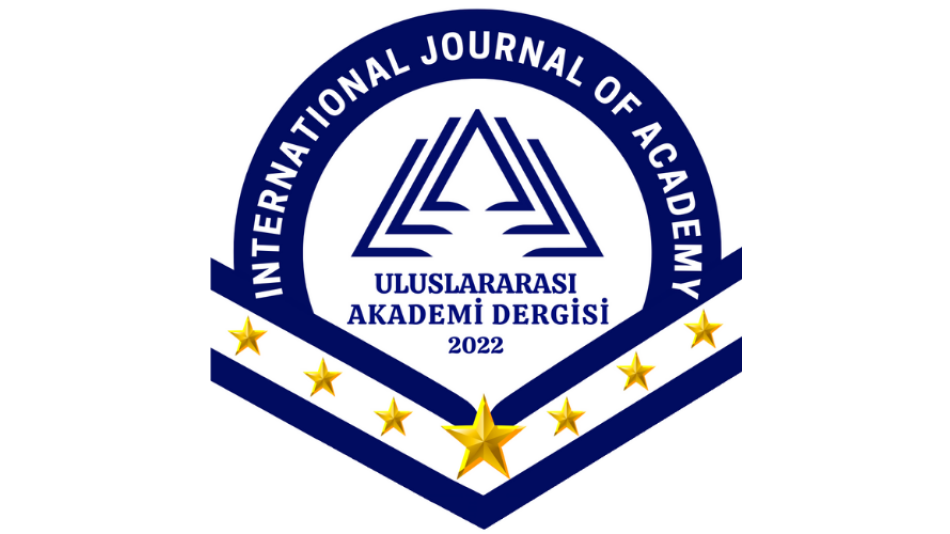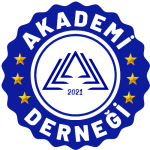CORPORATE
LATEST ANNOUNCEMENTS

Happy Eid al-Adha
05 June 2025
Dr. Ayhan Cankut, Tam Bağımsızlığa Atılan İlk Adım 19 Mayıs 1919 Başlıklı Konferansta Konuşmacı Oldu
22 May 2025
Happy 19th May Commemoration of Atatürk, Youth and Sports Day!
19 May 2025
Training by Our President Assoc. Prof. Onur Başar Özbozkurt for the Mersin Journalists Association
01 May 2025
Happy May 1st – Labor and Solidarity Day
01 May 2025
All manuscripts submitted to the International Journal of the Academy must be appropriate to the Template.
Plagiarism Report of all manuscripts must be uploaded for the International Journal of the Academy.
Copyright Transfer Form must be uploaded for all manuscripts for the International Journal of the Academy.
Page Format
Article files should be provided in Microsoft Word format.
A4 Portrait, Margins (Normal- top, bottom, left, right 2,5 cm), single line spacing, Line spacing before or after paragraphs should be 6nk. You should not use indentation to indicate the start of a new paragraph.
It should be written in Times New Roman, 12-point size.
Article length should not be more than 20 pages including abstract and references.
Author details
The first page of the article should be arranged as the page containing only the author’s information. All contributing authors’ names and affiliation should be added. Correct email addresses should be supplied for each author in their separate author accounts. All contributing authors’ ORCID ID should be added.
Ethics committee approval should be obtained separately for research in all disciplines and for clinical and experimental studies on humans and animals that require an ethical committee decision, this approval should be stated and documented in the article. In studies requiring ethical committee permission, information about the permission (board name, date and issue number) should be included in the method section and on the first/last page of the article. In case reports, information about signing the informed consent/consent form should be included in the article.
Also, at the end of the article, Researchers’ Contribution Statement, Support and Acknowledgment Statement, if any, and Conflict Statement should be included.
Article Title
A title of the studies should not be more than 16 words should be provided. In Turkish articles, the title of the article in English should also be included.
Abstract Section
The abstract section should contain Times New Roman 10 points, minimum 150-maximum 250 words. Authors should avoid the use of personal pronouns within the structured abstract and body of the paper (e.g. “this paper investigates…” is correct, “I investigate…” is incorrect).
Keywords
Authors should provide appropriate and short keywords that encapsulate the principal topics of the paper. The number of keywords should be 3-5.
Headings
Headings must be concise, with a clear indication of the distinction between the hierarchy of headings.
The preferred format is for first level headings to be presented in bold format (e.g. Conceptual Background).
In subheadings, only the first letter of the first word should be capitalized and the rest should be lowercase, bold, and italic (e.g. Managing stress)
Introduction
The objective of the introduction part is to put the scope of the study in a frame, thus enabling the reader to link the study under consideration with other studies in the literature.In this section, the author is expected to present the objective, theoretical background, and contribution to the field as well as the originality. The introduction section should contain below:
- Stating the research problem
- Stating the research objective
- Literature review
- Research questions/hypotheses
Method
Method section should cover “Research Model”, “Population and Sampling (if any)”, “Data Collection Tools, and “Data Analysis” headings. The research model employed (descriptive, experimental, case study, observation, focus group, etc.) has to be stated in the method section. Besides, this section also hosts what research method or paradigm (i.e. qualitative, quantitative, ethnographic, etc.) has been employed.
The universe and sample used in the article should be explained in the method section. What the data collection tools used in the article are, and how the validity and reliability studies of these tools are carried out should be given in detail under the method heading. At the same time, how the data is analyzed after collection and the statistical methods used in the analysis should also be included. The Methods section is where the article explains exactly what, how to do it, and which method to use. Therefore, it is of great importance.
Findings
The findings section of the research paper is where you report the findings of your study based upon the information gathered as a result of the methodology [or methodologies] you applied. This section should simply state the results, without bias or interpretation, and arranged in a logical sequence.
In this section it is recommended that you should be concise, using non-textual elements, such as figures and tables, if appropriate, to present results more effectively. Tables, graphs etc. other figures should be indicated at the end of the relevant sentence at the appropriate time in the article, and in this way, the reader should be directed to the right graphic, figure or table at the right time.
Conclusion and Discussion
The conclusion is intended to help the reader understand why your research should matter to them after they have finished reading the paper. A conclusion is not merely a summary of your points or a re-statement of your research problem but a synthesis of key points. The conclusion offers you a chance to elaborate on the significance of your findings.
Besides, this section offers new insight and creative approaches for framing/contextualizing the research problem based on the results of your study.The purpose of the discussion is to interpret and describe the significance of your findings in light of what was already known about the research problem being investigated, and to explain any new understanding or fresh insights about the problem after you’ve taken the findings into consideration. The discussion will always connect to the introduction by way of the research questions or hypotheses you posed and the literature you reviewed, but it does not simply repeat or rearrange the introduction; the discussion should always explain how your study has moved the reader's understanding of the research problem forward from where you left them at the end of the introduction.
The main questions to be answered in the discussion section should be:
- Do the findings answer the hypotheses or research questions? If so, how are the findings interpreted?
- Are there findings that differ from those expected?
- What was learned from the analyzes made?
- Are the findings consistent or inconsistent with previous studies?
- What are the conclusions from the findings?
- How is the problem explored or illustrated in the introduction now understood?
- What could be the next step after this study?
Tables and Figures
The title and text properties of tables and figures should be given by considering the structure in the examples in the “Template”.
Give every table and figure a brief but clear and explanatory title. The caption for a table should appear above the table, while the caption for a figure should appear below the figure.
Tables should be justified in the text. To avoid any unintended changes during the copy-editing process, please use the drawing canvas function for figures in Microsoft Word.
Use Times New Roman-10 punto size for table/figure captions and the content. Boldface the word “Table” or “Figure"” and the associated number in the caption (see below).
e.g. Table 1. Systematic Literature Review
e.g. Figure 1. The Stages of Crisis Management
References
References to other publications must be in the most updated version of APA style and carefully checked for completeness, accuracy, and consistency. This is very important in an electronic environment because it enables your readers to exploit the Reference Linking facility on the database and link back to the works you have cited through CrossRef.
- You should cite publications in the text: (Özbozkurt, 2018:15) using the first named author’s name or (Yeşilkuş and Özbozkurt, 2021:15) citing both names of two, or (Özbozkurt et al., 2019:15), when there are three or more authors.
At the end of the paper, a reference list in alphabetical order should be supplied.
All references should be arranged hanging as in the template.
For Journals
Surname, Initials. (Year). Title of the article. Journal Name, Volume(Issue), pages.
Örnek: Yeşilkuş, F. & Özbozkurt, O. B. (2020). A contemporary management practice: Mindfulness in the work settings. European Journal of Educational and Social Sciences, 5(2), 145-158.
For Books
Surname, Initials. (Year). Title of the book. Place of Publication: Publisher.
e.g. Correia, D. (2014). Business Continuity. New York: Elseiver.
e.g. Özbozkurt, O. B. & Yeşilkuş, F. (2021). Organizasyon nasıl yönetilir? İş’te yönetim. Turkey: Astana Yayınları.
Foor Book Chapters
Surname, Initials. (Year). Chapter title. Editor’s Surname, Initial. (Ed.), Title of book (pages), Place of Publication: Publisher.
e.g. Miller, F. A. (2015). Managing risks in business. Jackson, A. (Ed.), Business management (ss. 15-20), New York: Elsevier.
For Conference Proceedings
Surname, Initials. (Year). Title of paper. Title of published proceeding which may include place and date(s) held, Place of publication, Publisher, Page numbers.
e.g. Jakkilinki, R., Georgievski, M. & Sharda, N. (2007). Connecting destinations with an ontology-based e-tourism planner. Information and Communication Technologies in Tourism, in Ljubljana, Slovenia, 2-5 April 2007, Vienna, Springer-Verlag, 12-32.
For Encyclopedia Entries (with no author or editor)
Title of Encyclopedia (Year). Title of entry. Volume, Edition, Title of Encyclopedia, Publisher, Place of Publication, pages.
e.g. Encyclopaedia Britannica (1990). Culture contact. Vol. 1, 13th ed., Encyclopaedia Britannica, London and New York, NY, 255-256.
For Electronic Sources
Kullanılan kaynak online bir kaynak ise, referansın sonunda URL adresi ve erişim tarihi verilmelidir.
e.g. Özbozkurt, O. B. (2022). Tutum ve davranışları anlayarak bilişsel uyumsuzluğu yönetmek. Retrieved from: https://hbrturkiye.com/blog/tutum-ve-davranislari-anlayarak-bilissel-uyumsuzlugu-yonetmek, Retrieved date: 15.11.2022.
Authors should write Disclosure Statements after the references section:
Beyan ve Açıklamalar (Disclosure Statements)
1. Bu çalışmanın yazarları, araştırma ve yayın etiği ilkelerine uyduklarını kabul etmektedirler (The authors of this article confirm that their work complies with the principles of research and publication ethics).
2. Yazarlar tarafından herhangi bir çıkar çatışması beyan edilmemiştir (No potential conflict of interest was reported by the authors).
3. Bu çalışma, intihal tarama programı kullanılarak intihal taramasından geçirilmiştir (This article was screened for potential plagiarism using a plagiarism screening program).

